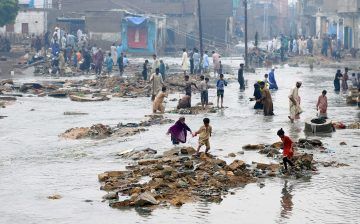Fatima Bhutto in The New York Times:
 Karachi is home. My bustling, chaotic city of about 20 million people on the Arabian Sea is an ethnically and religiously diverse metropolis and the commercial capital of Pakistan, generating more than half of the country’s revenue. Over the decades, Karachi has survived violent sectarian strife, political violence between warring groups claiming the city and terrorism. Karachi has survived its gangsters sparring with rocket launchers; its police force, more feared than common criminals; its rulers and bureaucrats committed to rapacious, bottomless corruption. Now Karachi faces its most terrifying adversary: climate change.
Karachi is home. My bustling, chaotic city of about 20 million people on the Arabian Sea is an ethnically and religiously diverse metropolis and the commercial capital of Pakistan, generating more than half of the country’s revenue. Over the decades, Karachi has survived violent sectarian strife, political violence between warring groups claiming the city and terrorism. Karachi has survived its gangsters sparring with rocket launchers; its police force, more feared than common criminals; its rulers and bureaucrats committed to rapacious, bottomless corruption. Now Karachi faces its most terrifying adversary: climate change.
In August, Karachi’s stifling summer heat was heavy and pregnant. The sapodilla trees and frangipani leaves were lush and green; the Arabian Sea, quiet and distant, had grown muddy. When the palm fronds started to sway, slowly, the city knew the winds had picked up and rain would follow. Every year the monsoons come — angrier and wilder — lashing the unprepared city. Studies show that climate change is causing monsoons to be more intense and less predictable, and cover larger areas of land for longer periods of time. On Aug. 27, Karachi received nearly nine inches of monsoon rain, the highest amount of rainfall ever in a single day. Nineteen inches of rain fell in August, according to the meteorological officials. It is enough to drown a city that has no functioning drainage, no emergency systems and no reliable health care (except for those who can pay). Thousands of homes and settlements of the poor were subsumed and destroyed, and more than 100 people were killed.
More here.
